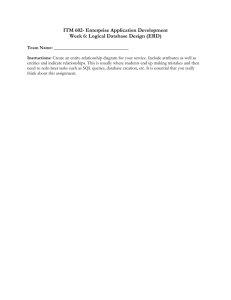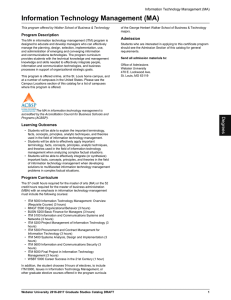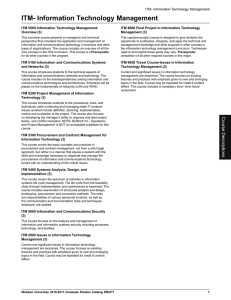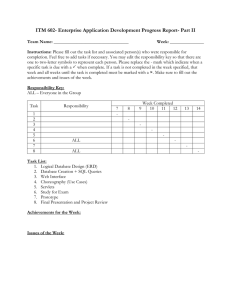IG to ITM Migration_updated March 2011
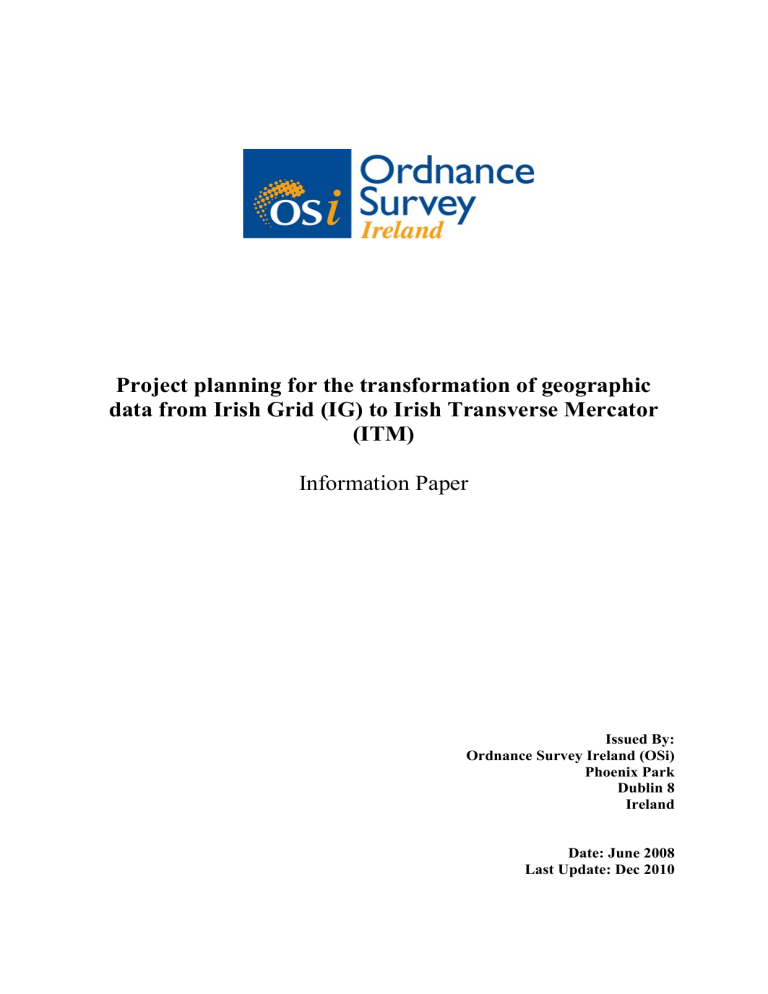
Project planning for the transformation of geographic data from Irish Grid (IG) to Irish Transverse Mercator
(ITM)
Information Paper
Issued By:
Ordnance Survey Ireland (OSi)
Phoenix Park
Dublin 8
Ireland
Date: June 2008
Last Update: Dec 2010
June 2008 Transformation of data from IG to ITM
Table of contents:
Why was ITM developed?............................................................................ 4
Improved Positional Accuracy...................................................................... 5
Use of the active GPS control network ........................................................ 5
Standardised co-ordinate system for Europe ............................................... 5
Compatibility with other ITM users ............................................................... 6
Assessment of requirements...................................................................... 10
Upgrade software to process ITM data ...................................................... 11
Test migration of samples of each type of data.......................................... 12
Obtaining and loading ITM mapping .......................................................... 12
Migration of overlay data in chunks and checking...................................... 12
Migration of discrete datasets and checking .............................................. 13
Migration of other geo-referenced datasets and checking ......................... 14
Check applications on new data ................................................................ 14
Modify user business processes ................................................................ 14
Ordnance Survey Ireland (OSi) Page 2
June 2008 Transformation of data from IG to ITM
1. Introduction
The purpose of this document is to assist users of Ordnance Survey Ireland (OSi) data to migrate from Irish Grid (IG) to Irish Transverse Mercator (ITM).
This document is the latest in a series of consultation and information papers issued by OSi and key stakeholders; notable dates in the lineage of ITM include:
1999 Concept introduced at ‘Survey Ireland 1999’ conference
2000 Preliminary user information circulated
2001 Consultation paper circulated
2001 ITM parameters formally adopted at ‘Survey Ireland 2001’
2002 OSi converts production flowlines to ITM
2002/3 ITM Technical Working Group
2002 ‘Grid InQuest’ transformation utility available
2004 Irish Institution of Surveyors (IIS) recommends ITM adoption
2005 Property Registration Authority goes digital with ITM
Key reference documents and papers include:
1999 - Making Maps Compatible with GPS
(see: http://www.osi.ie/en/alist/publications-papers.aspx)
2000 - A New Co-ordinate System for Ireland - Preliminary User Information
2001 - Co-ordinate Positioning Strategy - Information Paper
2001 - New Map Projections for Ireland - Consultation Paper
(see http://www.osi.ie/en/alist/publications-papers.aspx)
Ordnance Survey Ireland (OSi) Page 3
June 2008 Transformation of data from IG to ITM
1.1 What is ITM
ITM is a newly derived GPS compatible mapping projection that is associated with the
ETRS89 and the GRS80 ellipsoid. It takes advantage of the accuracy of GPS whilst minimising mapping distortions. The true origin and central meridian defined in the Irish
Grid is maintained, thus distributing the distortions due to the projection evenly.
Consideration was given to the introduction of a scale factor of unity on the central meridian.
However, using a scale of 0.99982 results in two standard parallels, and the magnitude and effects of scale change are minimised.
The position of the false origin is moved to a point 600,000m west and 750,000m south of the true origin. This results in grid co-ordinates that are significantly different from IG, but does not introduce additional distortion or complexity. The magnitude of the shift ensures that IG co-ordinates plotted on the ITM projection do not fall on Ireland or Northern Ireland, and vice versa.
Technical Information
Reference Ellipsoid : GRS80
Central Meridian
: 8°
Scale on CM : 0.999
Latitude ( Φ ) 53° 30' North
True Origin :
Longitude ( λ ) 8° 00’ West
600 000 W
False Origin (metres)
:
750 000 S
1.2 Why was ITM developed?
•
•
•
•
The extensive use of GPS in surveying
The need for interoperability between GPS & geographic data
International compatibility
Shortcomings of the ‘Irish Grid’ which: o Is not GPS compatible o Is dependant on a transformation relationship to GPS o Contains legacy distortion issues o Can only be realised to IG to better than 1m using GPS
Ordnance Survey Ireland (OSi) Page 4
June 2008 Transformation of data from IG to ITM
2. Benefits of Migrating to ITM
2.1 Compatibility with GPS
GPS and Irish Grid co-ordinates are based on different geodetic systems and are therefore not compatible. In order to overlay GPS data collected onto base-mapping in Irish Grid, the GPS co-ordinates need to be mathematically transformed to fit with the Irish Grid coordinates. This transformation results in a distortion of the GPS measurements. ITM is compatible with GPS data as both are based on a common geodetic datum (ETRF89), as a result, no transformation is needed to overlay GPS data on ITM mapping, therefore maintaining the accuracy of the GPS measurements.
2.2 Improved Positional Accuracy
One of the main benefits of the ITM map projection is the ability to obtain improved positional accuracy of data. This positional accuracy is achieved through;
•
Use of a co-ordinate system that is compatible with GPS
•
Use of new OS active control network for data capture
•
The collection and re-alignment of base OS map data to these standards
2.3 Use of the active GPS control network
The GPS network provides an infrastructure of permanently recording active GPS reference stations as a continuous network throughout Ireland. If users are using the ITM co-ordinate system, which is compatible with GPS, they can post-process data collected from low cost single GPS receivers with data from the active GPS control network. This will provide significantly improved accuracy than what would be originally obtained from the GPS, an accuracy that would normally only be achievable using a more expensive GPS system.
2.4 Standardised co-ordinate system for Europe
Data in ITM projection is compatible with the standard co-ordinate system used across
Europe (European Terrestrial Reference System – ETRF89 ). If standardisation with the
European Union is specified in a particular project, then use of the ITM co-ordinate system will ensure compliance with such specifications.
Ordnance Survey Ireland (OSi) Page 5
June 2008 Transformation of data from IG to ITM
2.5 Cheaper data capture
The benefits outlined above ultimately result in cheaper data capture for the user, the data can be input directly from the survey, no correction is needed which reduces processing time and costs. The data will also have an improved positional accuracy as a result of the use of ITM. The use of the active GPS control network allows the user to obtain accurate data using a much cheaper system.
2.6 Compatibility with other ITM users
Over time, it is expected that most users will migrate to ITM. By using the ITM map projection, users will have compatibility with other ITM users, which will make data interchange easier and remove the introduction of errors as a result of data transformation.
Currently the Property Registration Authority of Ireland (PRAI) have all 26 counties fully migrated to ITM projection.
Table July 2010 http://www.prai.ie/eng/landdirect_ie/landdirect_ie_News_Notices/Progress_Map_for_Rollout_of_Digital_Mapping_-_Updated_July_2010.shortcut.html
Ordnance Survey Ireland (OSi) Page 6
June 2008 Transformation of data from IG to ITM
2.7 Better map indexing
ITM provides continuous mapping, which means that there are no sheet boundaries as with IG data. However, a map index has been created which uses a 1km grid, with each
1km tile referenced by the co-ordinate location of the bottom left corner of that tile. The main advantage this square-based grid has over the current arbitrary sheet index is that it allows for faster access to map tiles through a better geo-referenced index. If the current sheet index was to be maintained the sheet numbers would bear no reference to the ITM co-ordinates. If the current sheet tiles were to be maintained and the reference number changed to the ITM co-ordinates of the bottom left corner, the translation would result in uneven numbers with up to 3 places of decimal. To base a tile name on the combination of these numbers would result in an impractical 12+ digit name, hence the decision to create a new 1km gridded index specific to ITM co-ordinates.
Ordnance Survey Ireland (OSi) Page 7
June 2008 Transformation of data from IG to ITM
3. Implications of moving to ITM
This section attempts to evaluate the implications of moving to ITM in terms of direct and indirect costs to the user, including the expected costs of project management.
3.1 Software costs
The migration process from IG to ITM may require an upgrade in standard software and in-house software/applications. The cost of this should be included within the software maintenance costs of the user business. The user may also need to purchase stand alone translation software or a translation service from a solutions provider. OSi have provided a free online co-ordinate converter at http://www.osi.ie/en/alist/co-ordinate-convertertool.aspx OSi have also produced a .dll file which has been made freely available to all major software providers to allow them to easily integrate the transformation polynomial in their software.
3.2 Hardware costs
It may be necessary to provide extra hardware for the extra data storage required during the data migration. This is likely to be required anyway as part of the continuing development programme, and can be planned for within the users hardware replacement programme.
3.3 Migration project costs
Once software to support ITM has been upgraded or installed, the cost of migrating from
IG to ITM is reduced to process of migrating the users own data to ITM, and the project management of this process. This is considered to be the main cost of migration, and ultimately involves the cost of staff time to undertake the work. If this migration project is planned carefully and implemented thoroughly, the cost of this work on the user should be minimal.
3.4 Project management costs
Project management activities may include:
•
Education in the requirements and implications of migration process
•
Planning the process (obtaining timings for release of new data and software and estimating resources required for process (staff, time, hardware)
•
Managing the migration process;
•
Quality assessment of the migrated data
Ordnance Survey Ireland (OSi) Page 8
June 2008 Transformation of data from IG to ITM
4. General Migration Process
In order to carry out a successful migration from IG to ITM, the following provides a simple
11-point plan:
1.
Assess requirements
- identify the datasets to be converted
2.
Plan migration project
- produce a detailed project plan
3.
Upgrade software
- to ensure that your software can process ITM
4.
Upgrade GPS devices
- to ensure that the GPS devices provide co-ordinates in ITM
- to ensure that ITM mapping is supported
5.
Test migration of samples of data
- for each type of data
6.
Obtain and load ITM mapping
- ITM data is available from OSi
7.
Migrate overlay data in chunks
- check to ensure successful conversion
8.
Migrate discrete datasets
- check to ensure successful conversion
9.
Migrate other geo-referenced datasets (if required)
- check to ensure successful conversion
10.
Check applications on new data
- to ensure that they function
11.
Modify business processes where incompatible with third parties
- for example where input or output is in different coordinates
Ordnance Survey Ireland (OSi) Page 9
June 2008 Transformation of data from IG to ITM
5. Migration Plan
5.1 Assessment of requirements
Different types of data require different processes for conversion. Before commencing the conversion process, it is therefore necessary to catalogue the data that is to be converted. This cataloguing should identify all the datasets, categorised as follows:
• Mapping
– Copies of OSi data for traditional mapping use, held either as map tiles or as a continuous coverage.
• Mapping as background for user data
– Overlays to OSi map base, held either as map tiles or as a continuous coverage, e.g. utility underground plant data.
• Additional discrete geo-referenced data
– Aerial surveys, ether a strip of images, or a continuous coverage over a defined area.
– Engineering drawings, discrete geo-referenced plans.
– Local plans, discrete geo-referenced drawings.
• Other geo-referenced datasets
– Alphanumeric datasets that include coordinates (e.g. environmental observations).
• Data derived from map data
– Datasets derived from using map features to create new objects, e.g. land ownership parcels.
For each category of data (vector, raster or aerial photography, continuous or discrete, maintained, historic, archived):
– what coordinate reference system is used (IG, ITM, …)?
– how is the data related to OSi mapping (by coordinates, linked to cartographic features)?
– what is the positional accuracy requirement?
– what applications use the coordinates of the data?
– does the data need to be migrated?
Ordnance Survey Ireland (OSi) Page 10
June 2008 Transformation of data from IG to ITM
5.2 Migration project planning
Planning is the key to the conversion process. A detailed plan needs to be drawn up.
This should cover the stages identified here, with the detailed of how they will be carried out, by whom, when, and the resource requirements.
5.3 Upgrade software to process ITM data
Table 2 below outlines the current status of the main application providers. It will be necessary to confirm with your supplier whether they currently support ITM mapping and/or transformations, and if not, when they plan to implement this (if at all). It may be necessary to upgrade your software. Software applications which have been developed in-house will also need to be considered. Some data inputs and outputs may still require IG. Conversion between IG and ITM can be carried out in real-time for this (converters are available from OSI).
Current Status of Main Application Providers (updated March 2011)
ArcGIS
Yes, from version 9.x onwards are fully compliant in respect of ITM to IG and IG to ITM coordinate transformation. To access the methodology for performing this transformation, please go to http://www.esriireland.ie/products/ireland_NTv2.zip
Radius Vision Yes.
Spatial Studio
FME
MapInfo
Microstation
Oracle
Table 2
Yes.
Yes, using FME default Universal Translator EPSG 2157 to EPSG 29903 or FME Workbench EPSG 2157 to EPSG
29903 using Grid Inquest re-project
GIS software provider - Projection algorithm included in
9.0 releases – verification is on-going.
Yes, using Ireland-ITM Irish Transverse Mercator ETRF
1989 to IrishGrid 1975 Irish Grid, referenced to Ireland
1975
Yes for Oracle 11G R2 2157 to 29903 transformation with polynomial rule
Ordnance Survey Ireland (OSi) Page 11
June 2008 Transformation of data from IG to ITM
5.4 Test migration of samples of each type of data
Before carrying out migration, the migration process should be tested on samples of each type of data identified in the assessment of requirements.
5.5 Obtaining and loading ITM mapping
Digital map data and paper maps are available from OSi in the normal way.
Conversion is equivalent to receiving an update of the full set of map data. ITM data is continuous, and not based on map tiles like IG data.
5.6 Migration of overlay data in chunks and checking
Software for converting from IG to ITM may be provided either from your software supplier, or from OSi. For each type of data, the conversion process should be carried out in stages, for manageable “chunks” of data. This should include vector overlays, raster data and aerial photography. On completion of conversion, the data should be checked to ensure that it has been carried out successfully (completely and accurately).
5.7 Solutions Providers
The following companies can provide assistance in converting data from IG to ITM;
•
1Spatial
1 Nore House,
Riverview Business Park,
Mahon,
Cork
Tel: +353 (0)21 4359595
Fax: +353 (0)21 4359596
E-mail: info@1spatial.com
•
Atlas Computers
15 Moyville Lawns,
Taylors Lane. Rathfarham,
Dublin 16
Tel: +353 1 4958714
Fax: +353 1 4958717
E-mail: support@atlascomputers.ie
Ordnance Survey Ireland (OSi) Page 12
June 2008 Transformation of data from IG to ITM
•
Compass Informatics
19 Grattan Street
Dublin 2
Tel: +353-1-6612483
Fax: +353-1-661 2484
Web: www.compass.ie
•
•
ESBI Computing Ltd
27 Lower Fitzwilliam Street
Dublin 2
Tel: +353-1-7026768 / 7027275
Fax: +353-1-6618455
Web: www.esbic.ie
Gamma
4 Inns Court, Winetavern Street,
Dublin 8
Tel: +353-1-7079888
Fax: +353-1-6776787
Web: www.gamma.ie
•
•
IMGS
8b Keypoint, Rosemount Business Park
Dublin 15
Tel: +353-1- 8853839
Fax: +353-18853765
Web: www.imgs.ie
Mapflow
4 Merrion Square,
Dublin 2
Tel: +353-1- 634 1430
Web: www.mapflow.ie
5.8 Migration of discrete datasets and checking
Separate datasets, such as inset drawings and detailed plans may not need to be converted, as they can be converted “on the fly” if required. However, if they are required to be converted, on completion of conversion, the data should be checked to ensure that it has been carried out successfully (completely and accurately).
Ordnance Survey Ireland (OSi) Page 13
June 2008 Transformation of data from IG to ITM
5.9 Migration of other geo-referenced datasets and checking
Other datasets that do not appear to be map-based may nevertheless contain coordinates. Examples of this are environmental and other observational data. The occurrence of such coordinates needs to be identified, and they can be transformed by software. This may require help from your software supplier.
5.10 Check applications on new data
On completion of the conversion, all applications of the data need to be checked using test data, to ensure that they continue to work. This testing should be equivalent to the
User Acceptance Testing (UAT) for the application.
5.11 Modify user business processes
Where data is passed to or from other organisations, conversion between IG and ITM may be required in the process to ensure compatibility of data.
Ordnance Survey Ireland (OSi) Page 14
June 2008 Transformation of data from IG to ITM
6. Sample Local Authority Case Study
The local authority has:
• Two GIS for different applications
• A map library (all OSi vector, raster 6” & 50K, orthophotography)
• All mapping sheet based, not continuous
• Point locations of public buildings (including housing)
• Overlay polygons of planning applications
• Overlays of water & sewer networks
• Overlays of street furniture, highway maintenance, planned schemes
• Overlays of boundaries (high resolution)
• Project and scheme maps
• Historic archive of additional data (AutoCAD drawings)
• Input from contractors and consultants
• Supply data to National Roads Authority, Environmental Protection Agency, Planning
Appeals Board
Each of these aspects needs to be included in the migration plan, each following the appropriate migration method.
Ordnance Survey Ireland (OSi) Page 15
June 2008 Transformation of data from IG to ITM
6.1 Migrating different types of data
Migrating Mapping
OSi ITM digital map data is available from OSi in the normal way.
Migrating of non-OSi raster data and aerial photography
Raster images may only need to be transformed where they are used as a backdrop, e.g. orthophotos. They can be transformed using the IG to ITM transformation.
However, the joins between the pixels will be rotated forming cracks (lack of join along the edges) of what would previously have been seamless image maps. It may be better to get this done by an external service.
Creating map indexes
IG data was stored in map tiles, ITM data is a continuous dataset (which may be cut to a prescribed area using relevant coordinates).
Since ITM data is continuous and not based on map tiles like IG data, the concept of map sheets is no longer relevant. However, many organisations use map sheets as a way of accessing and referring to mapping. If required, a map sheet index equivalent to that used for IG data can be provided, defining the extent (in ITM) of each map sheet. This could be used to maintain existing user processes, and while not essential, may be necessary in applications that are based on map tiles. If your current mapping is not continuous, now would be a good time to move to continuous mapping.
Metadata
Metadata, describing the user data and the state of data maintenance, which may be based upon IG map tiles will also need to be upgraded.
Migrating vector overlay data
Software for converting from IG to ITM should be provided by your software supplier. Most suppliers provide coordinate transformations, and the relevant transformation parameters are available on the OSi website. OSi provide conversion routines from IG to ITM. The migration process should be carried out in stages, for manageable “chunks” of data.
Migrating discrete geo-referenced data
Discrete datasets such as aerial surveys, either a strip of images or a continuous coverage over a defined area, engineering drawings, local plans, discrete georeferenced plans and drawings, will not need to be migrated if they are not georeferenced (i.e. contain inherent coordinates to position them, e.g. by corner points).
Even if they are geo-referenced, they could be left as they are and converted “on the fly” if and when needed. However, if they are required to be converted, this should
Ordnance Survey Ireland (OSi) Page 16
June 2008 Transformation of data from IG to ITM not represent a problem to any geographic system. However the very size of raster images makes their manipulation much more problematic than for simple raster and attributed data. There are no geometrical or positional issues associated with this.
Migrating other geo-referenced datasets
Other datasets that do not appear to be map-based, may nevertheless contain coordinates. Examples of this are environmental and other observational data. The occurrence of such coordinates needs to be identified, and they can be transformed by software, if required. This may require help from your software supplier. In some cases coordinates can be left as they are and transformed on use.
Data derived from map data
If there are datasets derived from using map features to create new objects, e.g. land ownership parcels, two approaches are possible. One is to transform the coordinates as for other data containing coordinates. The other is to identify the features used to make up the object, and to take the corresponding feature from the ITM data.
Ordnance Survey Ireland (OSi) Page 17
June 2008 Transformation of data from IG to ITM
7. Quality checks
A formal process of quality checks is required to ensure that all the data has been successfully migrated. The following criteria could be used:
•
Completeness - Has all the data been converted?
To check this,
1.
Check that all files (datasets, drawings) have been migrated.
2.
For all major datasets, take a random selection of features (e.g. buildings), and check that they are in the migrated dataset.
•
Relative positional accuracy - Are there any gross errors?
To check this,
1.
For graphics files, compare visually for gross errors.
2.
For continuous mapping, make a visual check for gross errors at any internal file boundaries (edge matching).
•
Junction closing (overshoots/undershoots) - Are all junctions between links closed (nodes and polygons)
To check this, take a selection of areas (e.g. map tiles) and make a visual check that there are no unclosed junctions. If any are found, check that they whether or not they are in the original data.
•
Raster overlays - Does transformed dataset fit correct extent?
To check this,
1.
For a selection of files, check that they are in the correct place in space.
2.
For continuous coverage’s, check that there is continuity across the file boundaries. Note that there may be slight gaps or overlaps in raster data along the boundary of different files.
•
Edge matching – are there any mismatches across boundaries of map sheets?
To check this, for continuous map background and overlays, carry out a visual check across sheet boundaries, for gross mismatches. If any are found, check that they whether or not they are in the original data.
•
Use in applications - Do applications work with transformed data?
To check this, test each application (with test user data where appropriate) to ensure that it works. This test should be equivalent to the User Acceptance Test for the application.
Ordnance Survey Ireland (OSi) Page 18
June 2008 Transformation of data from IG to ITM
8. FAQ
1.
Do I need to migrate now?
It is not essential that you migrate now, but the longer that you delay, the more work you will have to do in the long run. It is important to plan now, to ensure that migration can be carried out with the minimum of effort, and to fit in with your other activities.
2.
Will conversion to ITM cause a mismatch between my overlay data and the base mapping
This will depend on the quality of your data. Where overlays are recorded on up-to-date OSi mapping, there should not be a problem as the same linear transformation is used for both sets of data, but where historic mapping is used
(for example county series) there could be a problem across sheet boundaries.
3.
How do I know if my mapping and applications software can cope with ITM?
Page 10 of this document outlines the current status of some of the main software providers. After consulting this, confirm status with your system supplier, and then carry out tests.
4.
Do we need to migrate all our data?
Not necessarily, once your data audit is complete you might decide to leave some data in IG, e.g. datasets that you keep for historical reference purposes only that were created in IG might be left in IG.
You could also elect to convert some data “on the fly” as you access it i.e. by using the convertor tools within your CAD / GIS software. However this decision means that you are now managing data within IG and ITM, and complications could result.
5.
Will migration take a long time?
Not if it is planned properly. It should only be a few days, depending on data volumes. Project management and quality checking are essential, and will take more time.
Ordnance Survey Ireland (OSi) Page 19
June 2008 Transformation of data from IG to ITM
6.
Will migration cost a lot of money?
The migration process from IG to ITM may require an upgrade in standard software and in-house software/applications. The cost of this will most probably be included within your software maintenance agreement. Outside of this the main costs will be in staff time for project management and quality assurance.
7.
How will migration of my data affect other organisations that I interchange data with?
Translators are available to transform input and output data between IG and
ITM. Eventually, all systems will use ITM rather than IG.
8.
Will migration lead to degradation in the quality of my data?
It should not have any significant effect. The decrease in positional accuracy due to transformation should be negligible, and more than offset by the improved positional accuracy of newly surveyed data.
9.
Where do I find the IG (Irish Grid) to ITM translator?
http://www.osi.ie/en/alist/co-ordinate-converter-tool.aspx
10.
Where so I get more information
1999 - Making Maps Compatible with GPS
(see: http://www.osi.ie/en/alist/publications-papers.aspx)
2000 - A New Co-ordinate System for Ireland - Preliminary User Information
2001 - Co-ordinate Positioning Strategy - Information Paper
2001 - New Map Projections for Ireland - Consultation Paper
Ordnance Survey Ireland (OSi) Page 20
